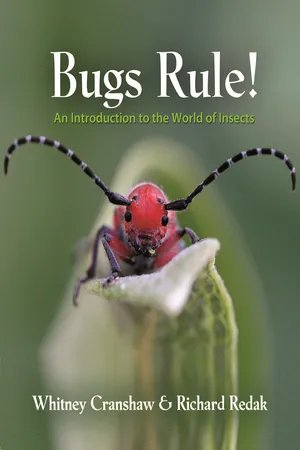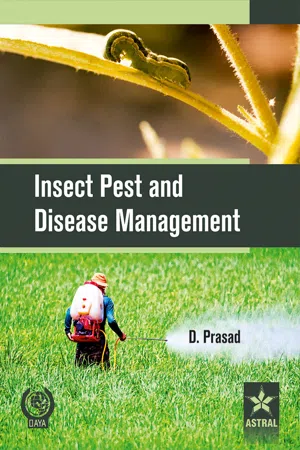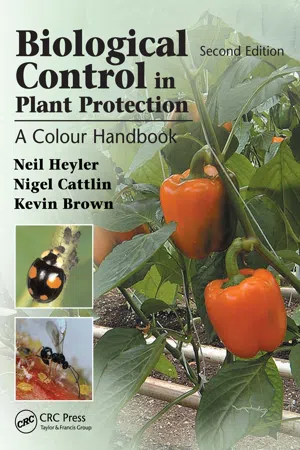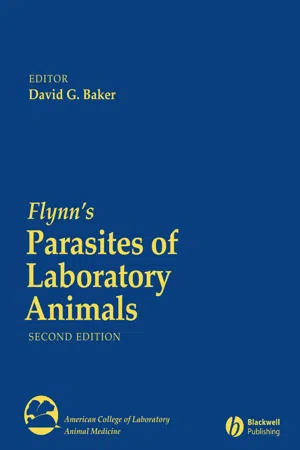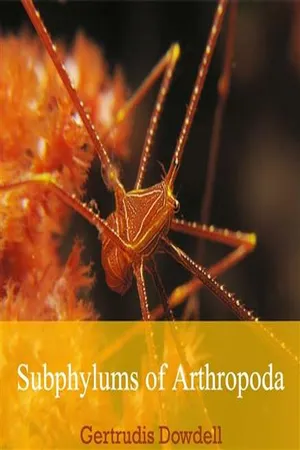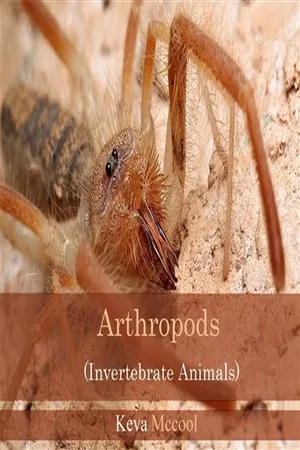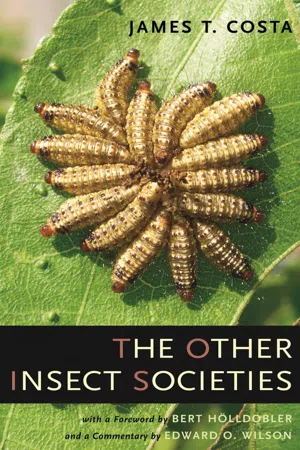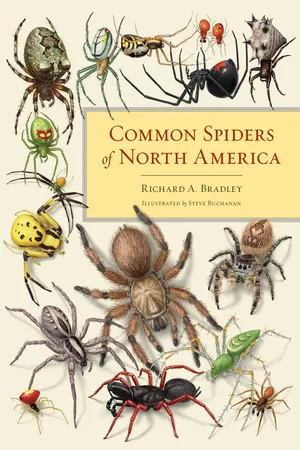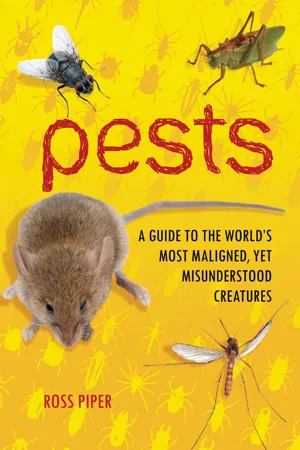Biological Sciences
Arachnids
Arachnids are a class of joint-legged invertebrate animals, including spiders, scorpions, ticks, and mites. They are characterized by having two body segments, eight legs, and no antennae. Arachnids play important roles in ecosystems as predators and scavengers, and some species are venomous. Their diverse adaptations have allowed them to thrive in various habitats worldwide.
Written by Perlego with AI-assistance
10 Key excerpts on "Arachnids"
- eBook - ePub
Bugs Rule!
An Introduction to the World of Insects
- Whitney Cranshaw, Richard Redak(Authors)
- 2013(Publication Date)
- Princeton University Press(Publisher)
5 The Arachnids—Spiders, Scorpions, Mites, and Other Eight-Legged WondersClass Arachnida
According to a classical Greek myth, Arachne was a mortal with a legendary ability to spin and weave. Her boastful pride in her abilities attracted the attention of Athena, the goddess of wisdom, arts and crafts, and strategy, prompting a weaving challenge match between the two. The tapestry Arachne wove was of superior workmanship but illustrated the foibles of the gods—a foolish choice of subject. Attempting to escape the wrath of Athena, she attempted to hang herself but was transformed into a spider by the vengeful goddess, forever doomed to spin. From this story comes the name “Arachnida,” given to a class of arthropods that include the spiders.Arachnida is a huge class of arthropods comprised of over 100,000 described species within 11 orders, second in number only to the hexapods. These include such familiar animals as spiders, opilionids (daddy longlegs), scorpions, mites, and ticks (figure 5-1 ). Arachnids have six pairs of appendages the first pair of which (chelicerae) function as mouthparts. In some Arachnids, such as spiders, the chelicerae have two segments: a base and a pointed fang. In others, such as windscorpions and pseudoscorpions, the chelicerae are developed into the form of pincers. The mouth opening of Arachnids is usually narrow, restricting most to feed primarily on liquids and small pieces of solid material.FIGURE 5-1The relative number of presently described species among the arachnid orders. Just over 100,000 arachnid species have been described, with Araneae (spiders) and Acari (mites and ticks) being particularly species rich. However, many arachnid groups are still very poorly described, most notably the mites. Figures based on Numbers of Living Species in Australia and the World - eBook - PDF
- Prasad, D(Authors)
- 2021(Publication Date)
- Daya Publishing House(Publisher)
Chapter 10 Spiders: Bio-ecology and Conservation for Insect Pest Management R.K. Tanwar, O.M. Bambawale and H.R. Sardana National Centre for Integrated Pest Management, L.B.S. Centre, I.A.R.I. Campus, New Delhi – 110 012 Introduction Arthropods represent an extremely successful group of animals which live in wide variety of habitats, have a great range of variation and include the greatest number of species. Arthropods constitute 64.5 per cent of the described species compared to plants (14.31 per cent), fungi (4.2 per cent) and vertebrates (2.3 per cent) (Anonymous, 1995). The Arachnids constitute the second largest class (7 per cent) of documented arthropods. Included in the Arachnids are the spiders, mites, ticks, scorpions, pseudoscorpions, harvestmen, whipscorpions and sundspiders. Out of 90,000 plus presently described arthropods species about 40,000 are spider species (Arachnida: Araneae) which are found all over the world in almost every kind of habitat. Spiders are important predators of pests of cotton, rice, apple, banana and various other crops and plantations and are of great value to the environment. They have a general blanket or buffer effect, promoting evolution, help keeping insect numbers under control in a broad sense and supplying food for many other animals and therefore, keeping the flow of life moving. Spiders represent more than 90 per cent of the natural enemies of brown planthoppers living in paddy fields in Korea (Lee et al ., 1997). They feed almost This ebook is exclusively for this university only. Cannot be resold/distributed. exclusively on insect but little attention has so far been paid into their possible use in Integrated Pest Management programme because until recently little was known of their ecology, especially as it pertains to interactions with associated prey populations and other arthropod competitors (Riechert and Lockley, 1984). - eBook - PDF
Biological Control in Plant Protection
A Colour Handbook, Second Edition
- Neil Helyer, Nigel D. Cattlin, Kevin C. Brown(Authors)
- 2014(Publication Date)
- CRC Press(Publisher)
They can be extremely numerous but often go unnoticed because of their size and relatively secretive habits. Different spider families have differ-ent techniques for catching their prey, with some spinning silken webs (Figure 4.1) and others jumping or running. Most will bite if handled roughly, but few are venomous to mammals. Like other arthropods, the Arachnids have an external skeleton and a body made up of a series of segments, each characterized by an internal nerve ganglion and a pair of jointed appendages. The body is divided into 69 Class: Arachnida (Spiders, Harvestmen, and Predatory Mites) Arthropod Biological Control Agents TABLE 4.1 Continued Subphylum (SP), class (C), subclass (SC), division (D) Order and suborder (SO) Family Genus and species Common name Page Aphelinidae Aphelinus abdominalis Aphid parasitoid 159 Encarsia formosa Whitefly parasitoid 161 Encarsia tricolor Whitefly parasitoid 163 Eretmocerus eremicus Whitefly parasitoid 164 Braconidae Aphidius colemani Aphid parasitoid 166 Aphidius ervi Aphid parasitoid 167 Cotesia glomerata Caterpillar parasitoid 168 Dacnusa sibirica Leaf miner parasitoid 169 Diaeretiella rapae Aphid parasitoid 170 Praon myziphagum Aphid parasitoid 171 Praon volucre Aphid parasitoid 171 Ichneumonidae Diadegma insulare Caterpillar parasitoid 172 Eulophidae Diglyphus isaea Leaf miner parasitoid 173 Tetrastichus asparagi Asparagus beetle wasp 175 Encyrtidae Encyrtus infelix Soft scale insects parasitoid 176 Leptomastix dactylopii Mealybug parasitoid 177 Leptomastix epona Mealybug parasitoid 177 Metaphycus helvolus Soft scale insects wasp 178 Tricho-grammatidae Trichogramma spp. Moth egg parasitoid 179 Crabronidae Cerceris arenaria Predatory wasp 180 Vespidae Vespula vulgaris Predatory wasp 181 - eBook - PDF
- David G. Baker(Author)
- 2008(Publication Date)
- Wiley-Blackwell(Publisher)
In most chelicerates, the coxae of one or more pairs of appendages are modified for grinding food and passing it to the oral cavity. The opisthosoma primi-tively comprises up to 12 segments, but abdominal seg-mentation is reduced or absent in many taxa. In several taxa the opisthosoma terminates in a tail, but appendages on the abdomen are usually absent. Arachnida The class Arachnida comprises the orders Acari (mites and ticks), Amblypygi (whipspiders), Araneae (spiders), Opiliones (daddy longlegs), Palpigradi (microscorpions), Pseudoscorpiones (pseudoscorpions), Ricinulei (ricin-uleids), Schizomida (short-tailed whipscorpions), Scorpi-ones (scorpions), Solifugae (sun spiders), and Uropygi (whipscorpions) 6 . Spiders make up the majority of the more than 38,000 species in the class, followed by ticks and mites with more than 30,000 species. While there are some ven-omous spiders and scorpions that could potentially affect laboratory animals, by far the most medically important Arachnids are the parasitic ticks and mites in the order Acari. All species of ticks and several species of mites are cosmopolitan parasites of endothermic and exothermic animals. Ticks and mites are morphologically similar, yet they have distinct differences. Most notably, ticks are large and easily macroscopic, while most mites, especially those species that are animal parasites, are small to microscopic. The classification of the Acari is unsettled, and can get somewhat complicated. Krantz 12 proposed two orders: Acariiformes (acariform mites) and Parasitiformes (ticks Fig. 6.3 Linguatula serrata nymph. Note spinous body rings and the two pairs of binate hooks. Courtesy of A. Fain, Institut de Médicine Tropicale Prince Léopold. Fig. 6.2 Linguatula serrata. (Left) Male. (Right) Female. Courtesy of A. Fain, Institut de Médicine Tropicale Prince Léopold. and parasitiform mites). Evans 13 elevates the Acari to sub-class level and recognizes two superorders and seven orders. - No longer available |Learn more
- (Author)
- 2014(Publication Date)
- White Word Publications(Publisher)
________________________ WORLD TECHNOLOGIES ________________________ Chapter 6 Arachnid Arachnida Temporal range: 420–0 Ma Silurian to Recent Arachnida from Ernst Haeckel's Kunstformen der Natur , 1904 Scientific classification Kingdom: Animalia Phylum: Arthropoda Subphylum: Chelicerata Class: Arachnida Cuvier, 1812 Orders Acarina Amblypygi ________________________ WORLD TECHNOLOGIES ________________________ Araneae †Haptopoda Opiliones Palpigradi †Phalangiotarbida Pseudoscorpionida Ricinulei Schizomida Scorpiones Solifugae Thelyphonida †Trigonotarbida Arachnids are a class ( Arachnida ) of joint-legged invertebrate animals in the sub-phylum Chelicerata. All Arachnids have eight legs, although in some species the front pair may convert to a sensory function. The term is derived from the Greek word ἀ ράχνη ( aráchnē ), meaning spider. Almost all extant Arachnids are terrestrial. However, some inhabit freshwater enviro-nments and, with the exception of the pelagic zone, marine environments as well. They comprise over 100,000 named species, including spiders, scorpions, harvestmen, ticks, mites and Solifugae. ________________________ WORLD TECHNOLOGIES ________________________ Anatomy Basic characteristics of Arachnids include four pairs of legs (1) and a body divided into two segments: the cephalothorax (2) and the abdomen (3). Almost all adult Arachnids have eight legs, and Arachnids may be easily distinguished from insects by this fact, since insects have six legs. However, Arachnids also have two further pairs of appendages that have become adapted for feeding, defense, and sensory perception. The first pair, the chelicerae, serve in feeding and defense. The next pair of appendages, the pedipalps have been adapted for feeding, locomotion, and/or repro-ductive functions. In Solifugae, the palps are quite leg-like, so that these animals appear to have ten legs. The larvae of mites and Ricinulei have only six legs; the fourth pair appears when they moult into nymphs. - No longer available |Learn more
- (Author)
- 2014(Publication Date)
- Research World(Publisher)
________________________ WORLD TECHNOLOGIES ________________________ Chapter- 3 Arachnid Arachnida Temporal range: 420–0 Ma Silurian to Recent Arachnida from Ernst Haeckel's Kunstformen der Natur , 1904 Scientific classification Kingdom: Animalia ________________________ WORLD TECHNOLOGIES ________________________ Phylum: Arthropoda Subphylum: Chelicerata Class: Arachnida Cuvier, 1812 Extant orders Acarina Amblypygi Araneae †Haptopoda Opiliones Palpigradi †Phalangiotarbida Pseudoscorpionida Ricinulei Schizomida Scorpiones Solifugae Thelyphonida †Trigonotarbida Arachnids are a class ( Arachnida ) of joint-legged invertebrate animals in the subphylum Chelicerata. All Arachnids have eight legs, although in some species the front pair may convert to a sensory function. The term is derived from the Greek word ἀ ράχνη ( aráchnē ), meaning spider. Almost all extant Arachnids are terrestrial. However, some inhabit freshwater environments and, with the exception of the pelagic zone, marine environments as well. They comprise over 100,000 named species, including spiders, scorpions, harvestmen, ticks, mites and Solifugae. ________________________ WORLD TECHNOLOGIES ________________________ Anatomy Basic characteristics of Arachnids include four pairs of legs (1) and a body divided into two segments: the cephalothorax (2) and the abdomen (3). Almost all adult Arachnids have eight legs, and Arachnids may be easily distinguished from insects by this fact, since insects have six legs. However, Arachnids also have two further pairs of appendages that have become adapted for feeding, defense, and sensory perception. The first pair, the chelicerae, serve in feeding and defense. The next pair of appendages, the pedipalps have been adapted for feeding, locomotion, and/or reproductive functions. In Solifugae, the palps are quite leg-like, so that these animals appear to have ten legs. - eBook - PDF
- James T. Costa(Author)
- 2006(Publication Date)
- Belknap Press(Publisher)
This chapter is thus a compromise: though at least five or six more chapters would be needed to do justice to the noninsect arthropods, I sketch here in this sin-gle chapter the range of sociality found in selected groups. And a sketch it is. I can-not go into nearly the depth or breadth of treatment of the other chapters. Nonethe-less, I hope that this account gives the reader a good feel for the diverse forms of arthropod sociality found beyond the Insecta—an enticement for a closer look. Arachnida Sociality is scattered throughout the class Arachnida, with forms of sociality like maternal care found in all arachnid orders, but it is uncommon in most groups taken individually. Here I consider the six most socially important arachnid groups: spiders (Araneae), tailless whipscorpions (Amblypygi), harvestmen (Opiliones), pseudoscorpions (Pseudoscorpionida), true scorpions (Scorpionida), and mites (Acari). All are arachnid orders with the exception of the mites, which are often treated as a subclass. For the latest overview of arachnid systematics and the relationships of these groups, visit the Tree of Life website at http:// tolweb.org/. Spiders (Araneae) “I will here mention a gregarious Epeira found in great numbers near St. Fe Bajada, the capital of one of the provinces of La Plata . . . . The webs were placed vertically, as is invariably the case with the genus Epeira: they were separated from each other by a space of about two feet, but were all attached to certain common lines, which were of great length, and extended to all parts of the community. In this manner the tops of some large bushes were encompassed by the united nets . . . . These gregarious habits in so typical a genus as Epeira, present a singu-lar case among insects [sic], which are so bloodthirsty and solitary, that even the sexes attack each other.” So wrote Charles Darwin in his Journal of Researches (1839, p. 42), later reprinted as The Voyage of the Beagle. - eBook - PDF
- Richard A. Bradley(Author)
- 2012(Publication Date)
- University of California Press(Publisher)
25 At first when we find a little creature, we want to know what type it is. The first step is to find out if it is a spider at all, or perhaps some simi-lar type of arthropod, such as a harvestmen. This step is really the recognition of a spider. We may also want to know what kind of spi-der we are looking at — for example, is it a wolf spider? This is identification to the level of the family. That information may be sufficient; because knowing what particular family a spi-der belongs to is the key to predicting its role in nature and many basic features of its biology. If we are willing to delve a bit deeper, we may try to identify the spider to the genus or even species level. RECOGNITION OF SPIDERS One of the first steps in learning about an unfa-miliar group of organisms is to learn how to recognize and then identify them. Spiders are usually easy to recognize as spiders, although a few mimic ants. Most people have already learned how to distinguish a spider from an insect. Spiders have eight legs, insects six. But of course there is more to it than that. There are a variety of other animals that resemble spiders; the arachnid relatives such as scorpions, mites, ticks, and harvestmen also possess eight legs. Spiders are placed in the order Araneae within the class Arachnida, one of 11 orders within this class found in North America (Fig. 4; Table). Other common Arachnids are sometimes confused with spiders. Perhaps the most fre-quently encountered animals that are mis-identified as spiders are the harvestmen, order Opiliones. These include the common daddy-longlegs of gardens and fields. Harvestmen can be distinguished from spiders by the fact that their body is fused into what appears to be one unit (Fig. 5). At the back of the body, the abdo-men is divided into segments; sometimes vis-ible as rings. Harvestmen have one conspicu-ous pair of eyes, often on a bump in the center of the head area. Spiders have two body regions without visible segments. - No longer available |Learn more
- (Author)
- 2014(Publication Date)
- Academic Studio(Publisher)
________________________ WORLD TECHNOLOGIES ________________________ Chapter- 8 Arthropod Arthropod Temporal range: 540–0 Ma Cambrian – Recent Extinct and modern arthropods ________________________ WORLD TECHNOLOGIES ________________________ Scientific classification Domain: Eukaryota Kingdom: Animalia Subkingdom: Eumetazoa Superphylum: Ecdysozoa Phylum: Arthropoda Latreille, 1829 Subphyla and Classes • Subphylum Trilobitomorpha o Trilobita – trilobites (extinct) • Subphylum Chelicerata o Arachnida – spiders, scorpions, etc. o Xiphosura – horseshoe crabs, etc. o Pycnogonida – sea spiders o Eurypterida – sea scorpions (extinct) • Subphylum Myriapoda o Chilopoda – centipedes o Diplopoda – millipedes o Pauropoda o Symphyla • Subphylum Hexapoda o Insecta – insects o Entognatha • Subphylum Crustacea o Branchiopoda – brine shrimp etc. o Remipedia o Cephalocarida – horseshoe shrimp o Maxillopoda – barnacles, fish lice, etc. o Ostracoda – seed shrimp o Malacostraca – lobsters, crabs, shrimp, etc. An arthropod is an invertebrate animal having an exoskeleton (external skeleton), a segmented body, and jointed appendages. Arthropods are members of the phylum Arth-ropoda (from Greek ἄ ρθρον arthron , joint, and ποδός podos foot, which together mean jointed feet), and include the insects, Arachnids, crustaceans, and others. Arthropods are characterized by their jointed limbs and cuticles, which are mainly made of α -chitin; the cuticles of crustaceans are also biomineralized with calcium carbonate. The rigid cuticle inhibits growth, so arthropods replace it periodically by molting. The arthropod body plan consists of repeated segments, each with a pair of appendages. It is so versatile that they have been compared to Swiss Army knives, and it has enabled them to become the most species-rich members of all ecological guilds in most environments. - eBook - PDF
Pests
A Guide to the World's Most Maligned, Yet Misunderstood Creatures
- Ross Piper(Author)
- 2011(Publication Date)
- Greenwood(Publisher)
FURTHER READING Arlian, L. G. Biology, host relations, and epidemiology of Sarcoptes scabiei. An- nual Review of Entomology 34(1989): 139–59. Chosidow, O. Scabies. New England Journal of Medicine 354(2007): 1718–27. Arachnids: SCORPIONS 13 Walton, S. F., and B. J. Currie. Problems in diagnosing scabies, a global disease in human and animal populations. Clinical Microbiology Reviews 20(2) (2007): 268–79. Scorpions These Arachnids are synonymous with danger as every single species is venomous and is capable of penetrating human skin with their sting. With this said, of the 1,400 or so known species of scorpion, only around 25 are known to be dangerous and capable of causing human death. The vast majority of scorpion envenomations are due to a handful of these species. The scorpions are an ancient, yet extremely successful group of inverte- brates that retain many of the features that enabled their distant ancestors to forsake the marine environment and conquer the land more than 400 million years ago. During this transition and in the eons that followed, scorpions evolved a host of adaptations to enable them to thrive on the land, often in habitats that are inhospitable to many other animals. Like Scorpions, like this Buthus occitanus use their venom with great effect to kill their prey and defend themselves. Only a small number of species are dangerous to humans. (Courtesy of Ross Piper) 14 Arachnids: SCORPIONS all arthropods, they have a tough exoskeleton that prevents excessive water loss; theirs appears to be particularly watertight, enabling these creatures to conserve water more effectively than most other arthropods. This wa- terproof armor coupled with their proclivity for carrying out most of their activities during the night means that many scorpions species are arid zone specialists, able to live quite happily in habitats where water is in extremely short supply.
Index pages curate the most relevant extracts from our library of academic textbooks. They’ve been created using an in-house natural language model (NLM), each adding context and meaning to key research topics.
